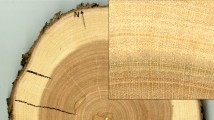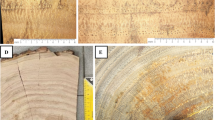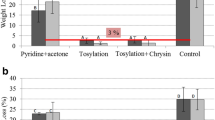Summary
The purpose of this study was to determine the progressive changes in physical and chemical properties of Eucalyptus globulus wood under the action of a representative white rot fungus, Coriolus versicolor. Observations concerning the nature and relative effects on weight loss, hot water solubility, 1% sodium hydroxide solubility, Klason lignin, holocellulose, intrinsic viscosity and degree of polymerisation of holocellulose, pentosans, methoxyl value, neutral sugar composition and nitrobenzene oxidation products are discussed.
Similar content being viewed by others
References
Ander, P.; Eriksson, K. E. 1978: Lignin degradation and utilization by micro-organisms. Progress in Industrial Microbiology 14: 1–58
Chang, H. M.; Chen, C. L.; Kirk, T. K. 1980: Chemistry of lignin degradation by white-rot-fungi. Lignin biodegradation, Microbiology and its potential applications, Vol. I pp. 215–230, CRC Press
Cowling, E. B. 1961: Comparative biochemistry of the decay of sweetgum sapwood by white-rot and brown-rot-fungi, U.S.D.A. Techn. Bull. No. 1258, pp. 27–79
Dagley, S. 1971: Catabolism of aromatic compounds by micro-organisms, Adv. Micro. Physiol. 6: 1–46
Eriksson, K. E. 1978: Enzyme mechanisms involved in cellulose hydrolysis by the white rot-fungus Sporotrichum pulverulentum. Biotechnol. Bioeng. 20: 317–332
Eriksson, K. E. 1980: Fungal degradation of wood components. Pure and Applied chemi. 53: 33–43
Harkin, J. M. 1967: Oxidative coupling of phenols pp. 243–341. New York: Marced Dekker
Hata, T. 1966: Investigation of lignins and lignification (XXXIII). Holzforschung 20: 142–147
Higuchi, T. 1980: Microbial degradation of Dilignols as lignin models. Lignin Biodegradation, Microbiology and its potential applications. Vol I pp. 171–194, CRC Press
Higuchi, T.; Kawamura, I.; Kawamura, H. 1955: Properties of the lignin in decayed wood. Nippon Ringaku Kaishi 37: 547–549
Immergut, E. H.; Schurs, J.; Mark, M. 1953: Mantahafut fur chemie. 84: 219–224
Ishihara, T.; Ishihara, M. 1976: Oxidation of syringic acid by fungal laccase. Mokuzai Gakkaishi 22: 371–375
Ishihara, T.; Miyazaki, M. 1974: Demethylation of lignin and lignins models by fungal laccase. Mokuzai Gakkaishi 20: 39–41
Ishikawa, H.; Schubert, W. J.; Nord, F. F. 1963: Investigations on lignins and its lignification XXVII. The enzymic degradation of soft-wood lignin by white rot fungi. Arch. Biochem. Biophys. 100: 140–149
Kirk, T. K. 1971: Effect of micro-organisms on lignin. Ann Rev. Phytopathology 9: 185–210
Kirk, T. K.; Chang, H. M. 1975: Decomposition of lignin by white-rot fungi II. Characterization of heavily degraded lignin from decayed spruce. Holzforschung 29: 56–64
Kirk, T. K.; Harkin, J. M.; Cowling, E. B. 1968: Degradation of the lignin model compound syringylglycol β-guaiacylether by Polyporous versicolor and Stereum trustulatum. Biochem. Biophys. Acta. 165: 145–163
Kirk, T. K.; Tien, M.; Faison, B. D. 1984: Biochemistry of the oxidation of lignin by Phanaerochaete chrysosporium. Biotech. Adv. 2: 183–199
Kirk, T. K.; Yang, H. H.; Keyser, P. 1978: The chemistry and physiology of the fungal degradation of lignin. Developments in Industrial Microbiology, Underkafler, L. A., Ed. American Institute of Biological Science, Washington, D.C. 19: 51–61
Liese, W.; Schmid, R. 1966: Untersuchungen über den Zellwandabbau von Nadelholz durch Trametes pini. Holz Roh-Werkstoff 24: 454–460
Seaman, J. F.; Moore, W. E.; Mitchell, T. L.; Millet, M. A. 1954: Techniques for the determination of pulp constituents by quantitative paper chromatography. Tappi 37: 336–343
Scheffer, T. C. 1936: Progressive effects of Polyporous versicolor on the physical and chemical properties of red gum. U.S.D.A. Tech. Bull No. 527: 45–55
Wise, L. W.; Murphy, M.; D. Addieco, A. A. 1946: Chlorite holocellulose, its fractionation and bearing on summative analysis and on studies on hemicelluloses. Paper Trade Journal 122: 34–43
Author information
Authors and Affiliations
Additional information
The authors thank Dr. P. S. Rehill, the then Officer-in-Charge, Forest Pathology Branch, for valuable suggestions and providing facilities for decay experiments
Rights and permissions
About this article
Cite this article
Bhandari, K.S., Bist, V. Effect of Coriolus versicolor on physico-chemical properties of Eucalyptus globulus wood. Wood Sci. Technol. 23, 163–169 (1989). https://doi.org/10.1007/BF00350938
Received:
Issue Date:
DOI: https://doi.org/10.1007/BF00350938




